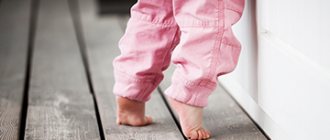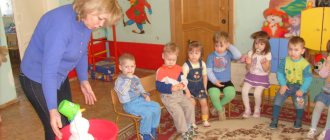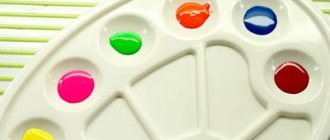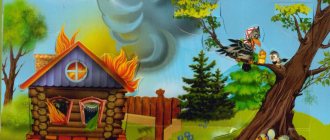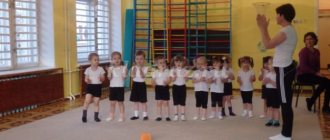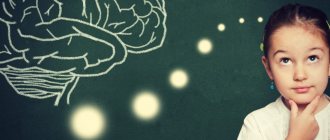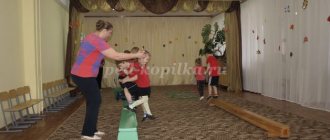Junior group. Early childhood, nursery. Children 1-4 years old
Summary of educational activities on FEMP with children 3–4 years old in the general developmental group “Research and experimentation “Properties”” Purpose: To show children that, in addition to sensory perceived signs, objects have properties that manifest themselves when they interact with each other. Objectives: To consolidate the ability to identify the properties of objects. Develop logical thinking. Activate the dictionary. Cultivate interest...
Summary of educational cognitive and research activities with children 3–4 years old “Magic Snow” MBDOU “Kindergarten”
Sun" Vuktyl 2022
Summary of educational cognitive and research activities with children 3-4 years old "Magic Snow"
Compiled by: Educator of the 1st category: Tumina O.P.
Type of activity : integrated (
cognitive-research , gaming) ...
Project on experimental research activities in the junior group “I Observe and Learn”
Project
in experimental research
activities
“I observe and learn
2021
Relevance of the project:
In preschool age, experimentation is the leading activity, and in the first three years it is practically the only way to understand the world. It is known that familiarization with any subject or phenomenon gives the most optimal result if it is effective. It is necessary to provide children with the opportunity to “act” with the objects they are studying in the surrounding world. Children love to experiment. This is explained by the fact that they are characterized by visual-effective and visual-figurative thinking. The main method of experimentation for children of primary preschool age, I chose to conduct elementary games - experiments.
Target:
Creating conditions for the formation of the foundations of a holistic worldview, through play through experimental activities.
Tasks:
1. Create conditions for children’s experimentation in the group room.
2. Expand children's understanding of the world around them.
3. Develop skills in conducting basic experiments with paper, sand, water, air (together with the teacher)
4. Develop thinking and speech in the process of cognitive and research activities.
5. Develop children’s cognitive activity in the process of experimentation.
Project type:
educational - playful.
Implementation period:
long-term 09/02/19 – 05/31/20
Project participants:
Children, teachers, parents.
Stages:
1. Preparatory.
Drawing up a project passport, preparing material for experimental activities, selecting games, riddles, poems.
2. Basic.
Planning educational activities, working with parents.
3. Final.
Create a corner for children in the group to independently experiment with natural and waste materials.
Long-term project planning
| date | subject | target | tasks | content |
| 04.09 | "Bubble". Consideration | Introducing children to soap bubbles. | Help raise the emotional mood of children. | Show the kids how to play with bubbles (catch them with your palms, jumping up, blow on them to make them fly away, watch) |
| 11.09 | "Ripples on the water." Experimentation | Development of the respiratory apparatus. | Encourage children to become interested in what is happening. | Place a bowl of water on the table. Draw children's attention to the fact that when you blow on some water, ripples appear on the surface. |
| 18.09 | "Bottles with a surprise." Experiment | Differences in auditory attention. | Encourage children to become interested in what is happening. | We take bottles with a surprise out of the box and show the children how to turn them over and shake them to make sounds. We tell you how it sounds - loud - quiet. |
| 25.09 | "Water cold and hot". Experiment | Teaching children to determine the temperature of substances and objects. | Develop tactile sensations. | Fill the bottles with hot and cold water. Let it touch and compare the temperature by touch. Talk about where the water is (cold, hot) |
| 02.10 | "Wonderful bag" (No. 1 in form) Experiment | Teaching children to identify an object by its shape by touch (ball, cube, brick). | Teach children to determine the shape of an object by touch (ball, cube, brick). | Teacher: “What do I have? Wonderful bag." Children take out balls, cubes, bricks from it, pronouncing the names of the figures together with the teacher. |
| 09.10 | "Air under water." Experiment | Observing what happens in the water when we blow into a straw. | Develop the breathing apparatus. | Insert a straw into a bottle (glass) with boiled water and blow into it. Bubbles appear. Encourage children to blow into their tubes too. |
| 23.10 | "Light heavy". Experience | Introducing children to the weight of objects. | Show that objects can be light and heavy. Learn to determine the weight of objects and group them by weight. | Two handbags. In one there is a balloon or pine cones (light bag), and in the other there are pebbles (heavy bag) |
| 06.11 | "Games with a sponge." Experiment | Creating conditions necessary for children's sensory development. | Introduce the properties of a sponge. Learn to pick up water with a sponge and squeeze it into a container. Cultivate interest in experimental activities. | The teacher deliberately spills water into the tray where the sponges lie, and then asks the children to help, remove it with the help of “helper sponges.” Having previously shown how this can be done. |
| 13.11 | "Balloons with a surprise." Consideration | Development of fine motor skills of the hands. | Develop tactile sensations. Arouse children's interest in the fact that different balloons have different fillings. | A dog came to visit with a box, and what is in it, I wonder? We take out balls filled with cereals (buckwheat, rice, millet, peas) and starch. We study them, touch them. |
| 20.11 | "Clothespins." Experimentation | Development of fine motor skills of the hands. | Develop fine motor skills of the hands. Teach children to press the edges of the clothespin to open it. | Draw the children's attention to the stretched ropes on which multi-colored clothespins hang. Show the children how to use clothespins. Encourage them to repeat these actions. |
| 27.11 | "Paper". Experiment | Introducing children to the properties of paper. | Introduce children to the properties of paper: it is light (can be blown away from the palm of your hand, crumples, tears, rustles, does not sink in water. Arouse interest in various manipulations with paper. | Start rustling with candy wrappers (paper, attracting children with an interesting sound. Let them try to crumple it themselves. Next, show different types of paper (napkin, candy wrapper, for drawing, etc.) and demonstrate what can be done with each of its types. |
| 04.12 | "Wonderful bag" №2 (by color). Experiment | Teaching children to match objects by color. | Develop tactile sensations. Give children the names of flowers and activate their speech. Create a positive emotional mood in children. | The teacher takes a figure (cube, ball, brick, triangle) of a certain color from the bag and asks the child to find the same one in the group. |
| 11.12 | "Game with a feather." Experimentation | Creating a positive emotional mood in children. | Form a vocabulary: parts of the body. Encourage children to pronounce words together with the teacher. | Take a colored feather and act according to the words: Look, look what I brought! It quietly crawls along the palm, First in a circle, then forward. It extends along the handle to the shoulder. And it very gently caresses the neck, crawls down the other hand, again quietly creeps along the palm, first in a circle, and then in flight. Where will it fly? Interest Ask. A feather landed on a small nose! Then the feather wants to stroke these ears. One and the other tickles a little. But now the feather needs to rest, It flies into your pocket to lie down. |
| 18.12 | "Games with sultans." Experiment | Developing in children the ability to exhale air through the mouth, activating the muscles of the lips. | To develop in children the ability to exhale air through the mouth. Introduce children to one of the properties of air - movement (wind). Creating a positive emotional mood. | Teacher: “What’s in my basket?” We get the sultanas. We blow (like the wind blows) - they move. If we don’t blow (no wind), they don’t move. |
| 25.12 | "Wonderful bag" №3 (feels like) Experiment | Development of tactile sensations. | Develop tactile sensations. Form a vocabulary: prickly, smooth, soft, hard. Create a positive emotional mood in children. | Teacher: “What do I have? Wonderful bag." Children take massage balls out of it (spiky balls, smooth balls, a fabric cube (soft, a plastic cube (hard).) Talking about each object what it is. |
| 15.01 | “Let’s hang up the handkerchiefs.” Experimentation | Development of fine motor skills of the hands. | Develop fine motor skills of the hands. Teach children to attach scarves to a string using clothespins. | Draw the children's attention to the washed handkerchiefs for the doll, which need to be dried. Show the children how to use clothespins to hang laundry. Encourage them to repeat these actions. |
| 29.01 | "Find by sound." Experiment | Fixing the names of musical instruments. | Identify and distinguish noise sounds made. Creating a positive emotional mood. Fix the names of musical instruments. | Toys came to visit us: a bear with a tambourine, a bunny with a rattle, a cat with a bell, etc. We hide it behind a screen and guess what it sounds like. |
| 05.02 | "Snow. What is he like? " Consideration | Introduction to the properties of snow. | Introduce the properties of snow in frosty weather (fluffy, cold, white, moldable, melts in your hands). Develop tactile sensations | Collect snow in a bowl and bring it to the group. Children get acquainted with its properties by touching it. |
| 19.02 | “What's in the package? " Experiment | Teaching children how to show. | Teach children to perform actions as shown by the teacher. Create a feeling of joy and interest. | We fill the plastic bag with air and close it. When we open the bag, the air comes out and the bag is empty. |
| 26.02 | “Open, close.” Experience | Development of fine motor skills of the hands. | Develop fine motor skills of children's hands. Encourage interest in what is in the jars. Increase emotional mood. | She brought jars with something inside (pine cones, toys, etc.). The boys and I are learning to open these containers and see what’s in there. |
| 03.03 | “Find the same bottle by sound.” Experience | Development of children's auditory attention. | Teach children to compare sounds and find similar ones. Cause joy and surprise in children. | Show the children a box with bottles (two each with the same fillings, filled with beans (peas, millet) (semolina, water. And, demonstrating how each of the bottles makes noise, offer to find the same one by sound. |
| 17.03 | "Let's play with the sun bunny" Consideration | Developing an understanding of the causes of sunbeams | Introduce the origin of sunbeams, their movement, the objects from which they are reflected. Develop ingenuity and curiosity. Teach children to act in accordance with the text, at the teacher’s signal; run in all directions without bumping into each other. Learn to let in sunbeams (reflect light with a mirror). Create a feeling of joy and surprise. | We looked out the window - the sun was shining. Educator: “What do I have in my hands? Mirror. Let's look for the bunny. Where is the bunny? Here he is. Who gave it? Sun. Let's play with him: Sunny bunnies are playing on the wall, lure them with your finger, they will come running to you. After a pause, he gives the signal: “Catch bunnies!” Children run to the wall and try to catch the bunny slipping from under their hands. |
| 01.04 | "The wind blows across the sea." Experience | Strengthening the ability to exhale air through the mouth, activating the lip muscles. | Continue to introduce children to such a natural phenomenon as wind. Learn to distinguish and regulate its strength yourself. Raising emotional mood in children. | There are paper boats in a basin of water. Children blow on the boats strongly - the boat floats, they blow quietly - it stands still. |
| 14.04 | "We play with sand." Experimentation | Development of fine motor skills of the hands. | Raise the emotional mood of children. Teach children to pour sand into different containers. | Show the children how to pour sand with a spoon into a funnel inserted into a bottle, and then from the bottle back into the box. Encourage them to do so themselves. |
| 28.04 | "Floats, sinks." Experience | Consolidating knowledge about the weight of an object. | Learn to identify light and heavy objects (some remain on the surface of the water, others sink). Help create a joyful mood. | We put stones in a basin of water - they sink, and plastic balls - they float. |
| 13.05 | “What’s in the tube? » Experiment | Developing curiosity in children. | Teach children to use a stick to push small objects out of a hollow tube (untie a bag with a toy, open a box). Develop perseverance and patience. Create a feeling of joy and surprise. Develop fine motor skills of the hands. | Place a toy wrapped in bright fabric or a box with a lid inside the tube. Show the tube to the baby and ask: “I wonder what’s in there?” If he doesn’t figure it out on his own, use a stick and show how you can use it to push out the package. Unfold it and show the toy, naming it. Let the child try to untie the bag himself. |
| 20.05 | "Samodelkin's board." Experiment | Development of fine motor skills of the hands. | Develop fine motor skills of the hands. Raise the emotional mood of children. | Draw the children's attention to a board with interesting devices, show how they can be manipulated. |
Literature
1. Dybina O. V. “Child in the world of search”; 2. Dybina O. V., Rakhmanova N. P., Shchetinina V. V. “The unknown is nearby” (entertaining experiences and experiments for preschoolers); 3. Zubkova N. M. “A cart and a little cart of miracles” (experiments and experiments for children, “scientific answers to children’s “whys.” 4. Ivanova A. I. “Methodology for organizing environmental observations and experiments in kindergarten.” 5 Ryzhova N.A. “Our home is nature” 6. A.I. Savenkova “Methods of conducting educational research in kindergarten” 7. Shapiro A. I. “Secrets of familiar objects”;
